Module 6 Eating together ·素养综合检测(含解析)
文档属性
| 名称 | Module 6 Eating together ·素养综合检测(含解析) | 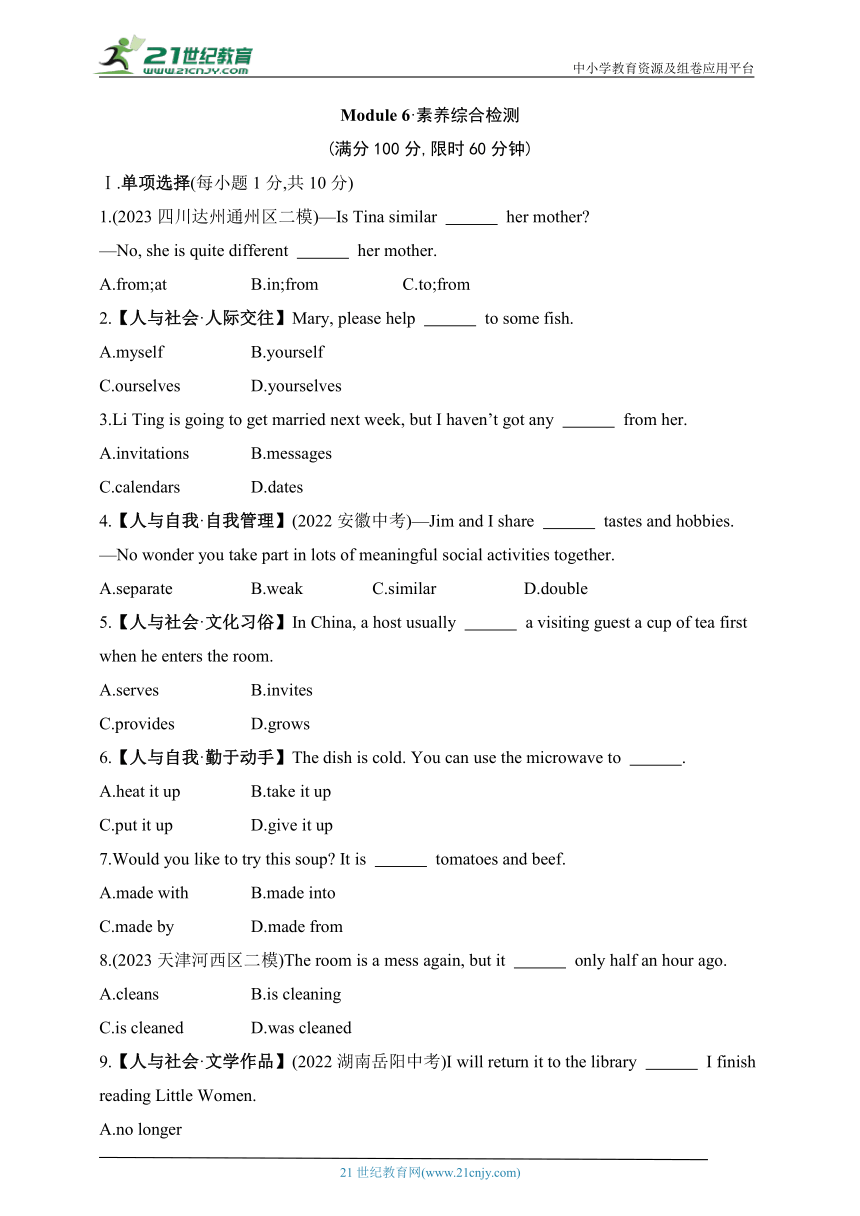 | |
| 格式 | docx | ||
| 文件大小 | 323.3KB | ||
| 资源类型 | 试卷 | ||
| 版本资源 | 外研版 | ||
| 科目 | 英语 | ||
| 更新时间 | 2023-12-08 10:48:21 | ||
图片预览

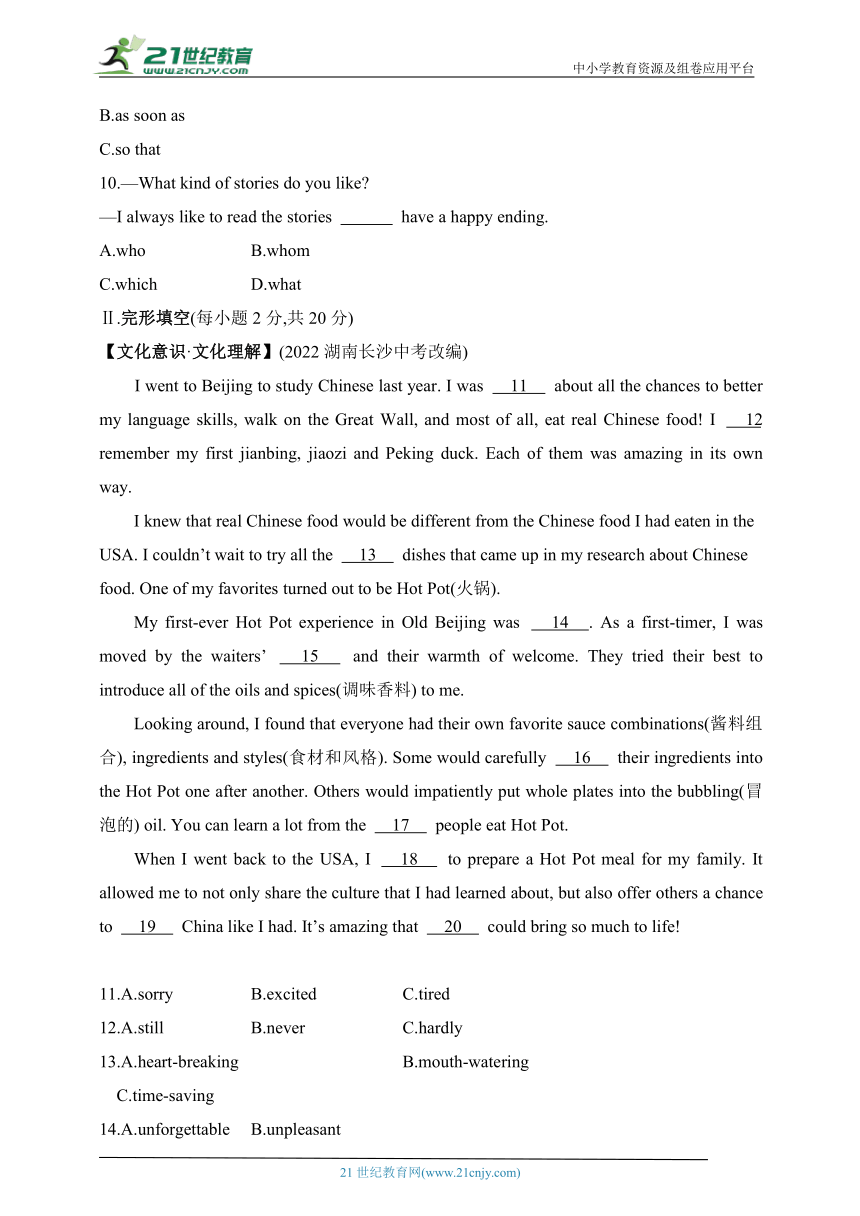
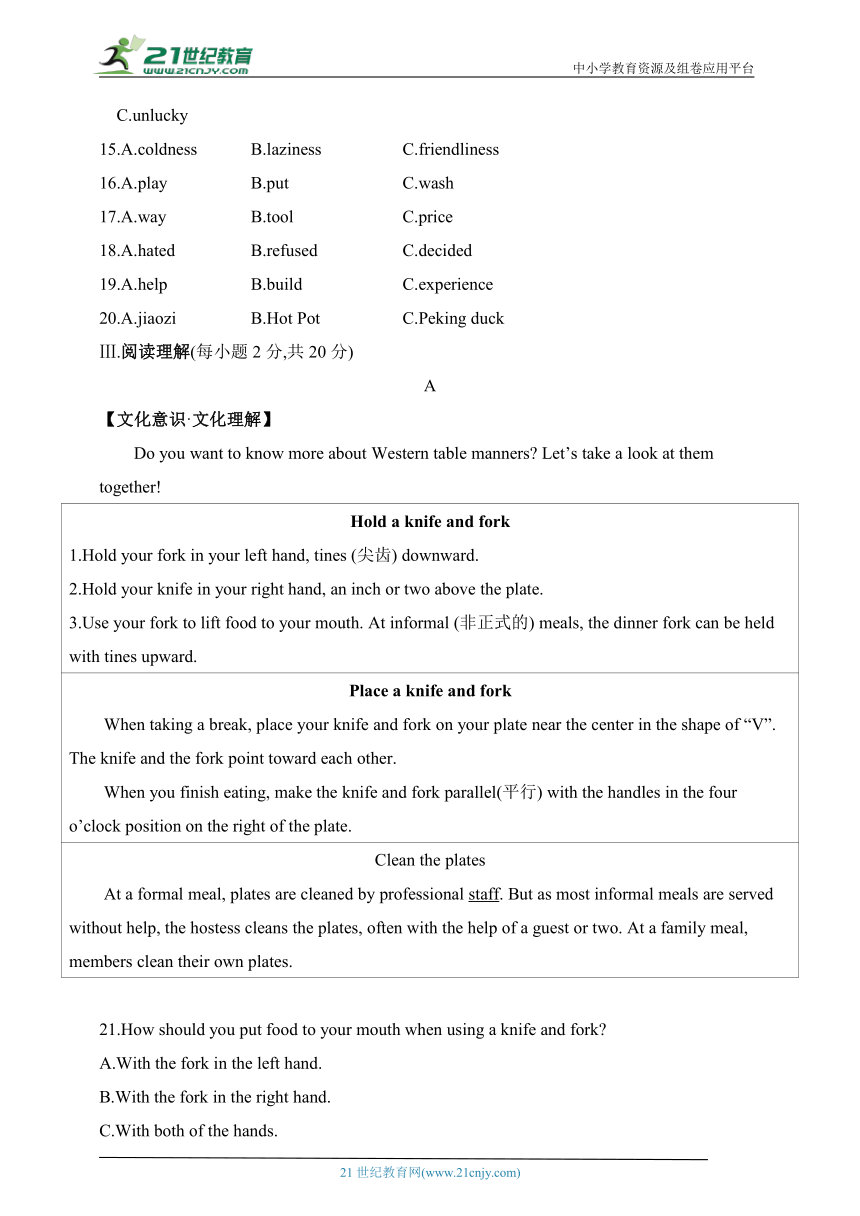
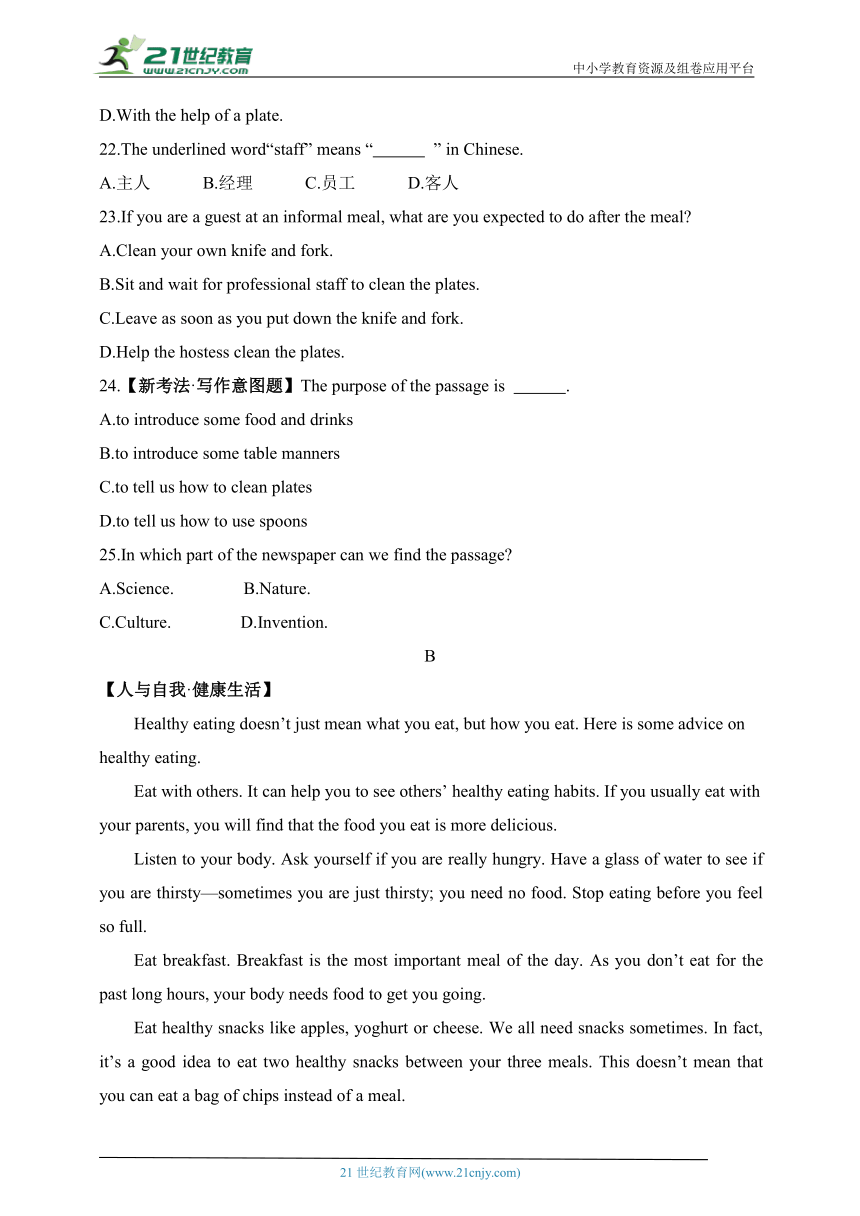
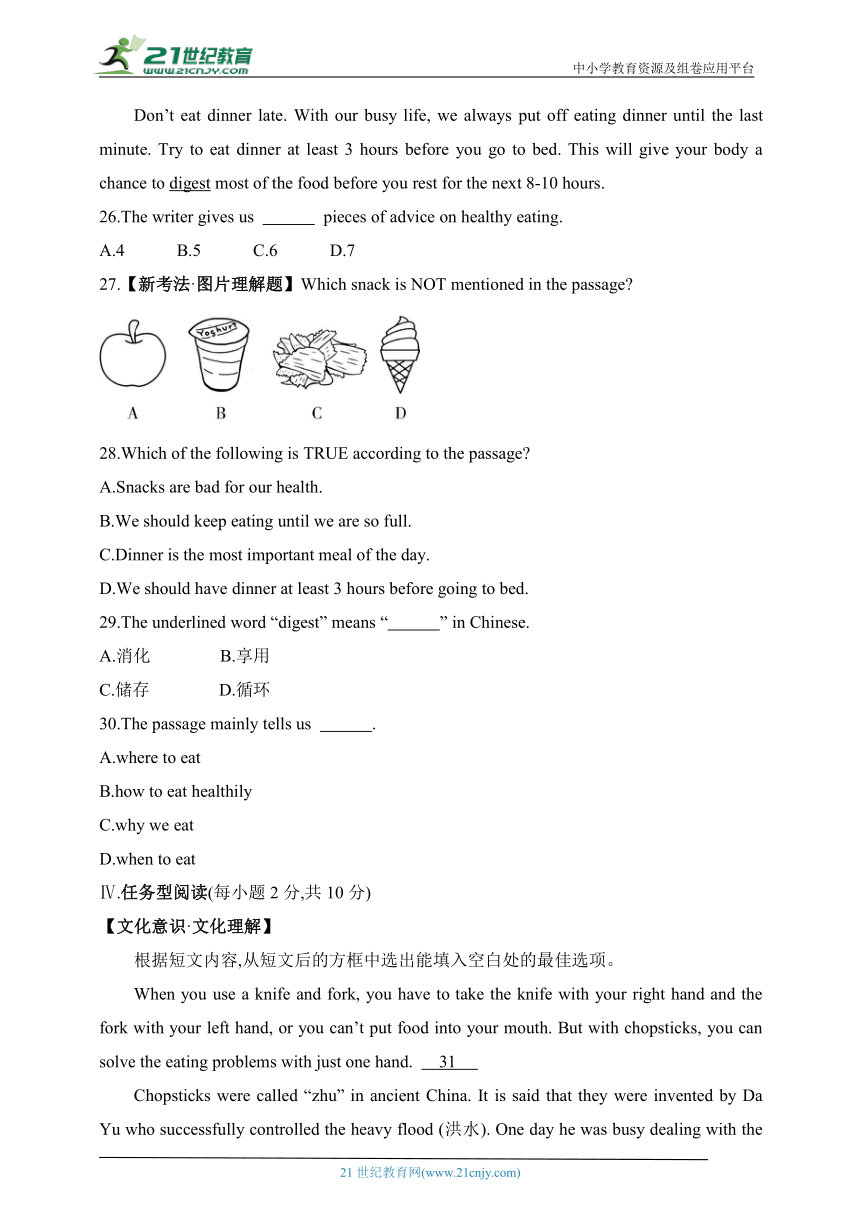
文档简介
中小学教育资源及组卷应用平台
Module 6·素养综合检测
(满分100分,限时60分钟)
Ⅰ.单项选择(每小题1分,共10分)
1.(2023四川达州通州区二模)—Is Tina similar her mother
—No, she is quite different her mother.
A.from;at B.in;from C.to;from
2.【人与社会·人际交往】Mary, please help to some fish.
A.myself B.yourself
C.ourselves D.yourselves
3.Li Ting is going to get married next week, but I haven’t got any from her.
A.invitations B.messages
C.calendars D.dates
4.【人与自我·自我管理】(2022安徽中考)—Jim and I share tastes and hobbies.
—No wonder you take part in lots of meaningful social activities together.
A.separate B.weak C.similar D.double
5.【人与社会·文化习俗】In China, a host usually a visiting guest a cup of tea first when he enters the room.
A.serves B.invites
C.provides D.grows
6.【人与自我·勤于动手】The dish is cold. You can use the microwave to .
A.heat it up B.take it up
C.put it up D.give it up
7.Would you like to try this soup It is tomatoes and beef.
A.made with B.made into
C.made by D.made from
8.(2023天津河西区二模)The room is a mess again, but it only half an hour ago.
A.cleans B.is cleaning
C.is cleaned D.was cleaned
9.【人与社会·文学作品】(2022湖南岳阳中考)I will return it to the library I finish reading Little Women.
A.no longer
B.as soon as
C.so that
10.—What kind of stories do you like
—I always like to read the stories have a happy ending.
A.who B.whom
C.which D.what
Ⅱ.完形填空(每小题2分,共20分)
【文化意识·文化理解】(2022湖南长沙中考改编)
I went to Beijing to study Chinese last year. I was 11 about all the chances to better my language skills, walk on the Great Wall, and most of all, eat real Chinese food! I 12 remember my first jianbing, jiaozi and Peking duck. Each of them was amazing in its own way.
I knew that real Chinese food would be different from the Chinese food I had eaten in the USA. I couldn’t wait to try all the 13 dishes that came up in my research about Chinese food. One of my favorites turned out to be Hot Pot(火锅).
My first-ever Hot Pot experience in Old Beijing was 14 . As a first-timer, I was moved by the waiters’ 15 and their warmth of welcome. They tried their best to introduce all of the oils and spices(调味香料) to me.
Looking around, I found that everyone had their own favorite sauce combinations(酱料组合), ingredients and styles(食材和风格). Some would carefully 16 their ingredients into the Hot Pot one after another. Others would impatiently put whole plates into the bubbling(冒泡的) oil. You can learn a lot from the 17 people eat Hot Pot.
When I went back to the USA, I 18 to prepare a Hot Pot meal for my family. It allowed me to not only share the culture that I had learned about, but also offer others a chance to 19 China like I had. It’s amazing that 20 could bring so much to life!
11.A.sorry B.excited C.tired
12.A.still B.never C.hardly
13.A.heart-breaking B.mouth-watering
C.time-saving
14.A.unforgettable B.unpleasant
C.unlucky
15.A.coldness B.laziness C.friendliness
16.A.play B.put C.wash
17.A.way B.tool C.price
18.A.hated B.refused C.decided
19.A.help B.build C.experience
20.A.jiaozi B.Hot Pot C.Peking duck
Ⅲ.阅读理解(每小题2分,共20分)
A
【文化意识·文化理解】
Do you want to know more about Western table manners Let’s take a look at them together!
Hold a knife and fork 1.Hold your fork in your left hand, tines (尖齿) downward. 2.Hold your knife in your right hand, an inch or two above the plate. 3.Use your fork to lift food to your mouth. At informal (非正式的) meals, the dinner fork can be held with tines upward.
Place a knife and fork When taking a break, place your knife and fork on your plate near the center in the shape of “V”. The knife and the fork point toward each other. When you finish eating, make the knife and fork parallel(平行) with the handles in the four o’clock position on the right of the plate.
Clean the plates At a formal meal, plates are cleaned by professional staff. But as most informal meals are served without help, the hostess cleans the plates, often with the help of a guest or two. At a family meal, members clean their own plates.
21.How should you put food to your mouth when using a knife and fork
A.With the fork in the left hand.
B.With the fork in the right hand.
C.With both of the hands.
D.With the help of a plate.
22.The underlined word“staff” means “ ” in Chinese.
A.主人 B.经理 C.员工 D.客人
23.If you are a guest at an informal meal, what are you expected to do after the meal
A.Clean your own knife and fork.
B.Sit and wait for professional staff to clean the plates.
C.Leave as soon as you put down the knife and fork.
D.Help the hostess clean the plates.
24.【新考法·写作意图题】The purpose of the passage is .
A.to introduce some food and drinks
B.to introduce some table manners
C.to tell us how to clean plates
D.to tell us how to use spoons
25.In which part of the newspaper can we find the passage
A.Science. B.Nature.
C.Culture. D.Invention.
B
【人与自我·健康生活】
Healthy eating doesn’t just mean what you eat, but how you eat. Here is some advice on healthy eating.
Eat with others. It can help you to see others’ healthy eating habits. If you usually eat with your parents, you will find that the food you eat is more delicious.
Listen to your body. Ask yourself if you are really hungry. Have a glass of water to see if you are thirsty—sometimes you are just thirsty; you need no food. Stop eating before you feel so full.
Eat breakfast. Breakfast is the most important meal of the day. As you don’t eat for the past long hours, your body needs food to get you going.
Eat healthy snacks like apples, yoghurt or cheese. We all need snacks sometimes. In fact, it’s a good idea to eat two healthy snacks between your three meals. This doesn’t mean that you can eat a bag of chips instead of a meal.
Don’t eat dinner late. With our busy life, we always put off eating dinner until the last minute. Try to eat dinner at least 3 hours before you go to bed. This will give your body a chance to digest most of the food before you rest for the next 8-10 hours.
26.The writer gives us pieces of advice on healthy eating.
A.4 B.5 C.6 D.7
27.【新考法·图片理解题】Which snack is NOT mentioned in the passage
28.Which of the following is TRUE according to the passage
A.Snacks are bad for our health.
B.We should keep eating until we are so full.
C.Dinner is the most important meal of the day.
D.We should have dinner at least 3 hours before going to bed.
29.The underlined word “digest” means “ ” in Chinese.
A.消化 B.享用
C.储存 D.循环
30.The passage mainly tells us .
A.where to eat
B.how to eat healthily
C.why we eat
D.when to eat
Ⅳ.任务型阅读(每小题2分,共10分)
【文化意识·文化理解】
根据短文内容,从短文后的方框中选出能填入空白处的最佳选项。
When you use a knife and fork, you have to take the knife with your right hand and the fork with your left hand, or you can’t put food into your mouth. But with chopsticks, you can solve the eating problems with just one hand. 31
Chopsticks were called “zhu” in ancient China. It is said that they were invented by Da Yu who successfully controlled the heavy flood (洪水). One day he was busy dealing with the flood. In order to save time when eating, he used two sticks from a tree to take the hot food. That was how chopsticks came into use. 32
In fact, the earliest chopsticks found in China were made of bronze (青铜). They were unearthed from the Ruins of Yin near Anyang, Henan.
Many people probably haven’t realized the cultural meanings of chopsticks.
33 Do you notice that one end of chopsticks is square and the other end is round So, why According to our ancestors, the round end stands for the heavens and the square end symbolizes the earth. 34 In Chinese culture, it shows the perfect combination (结合) of yin and yang.
The influence of Chinese culture has stretched (延伸) far and wide. 35 So it’s unbelievable that most foreigners cannot use chopsticks.
A.Besides, chopsticks are used in pairs.
B.It’s convenient and efficient (有效率的).
C.It was one of the stories about chopsticks.
D.At least 1.8 billion people are using chopsticks around the world.
E.They are regarded as one of the symbols of Chinese food culture.
31. 32. 33. 34. 35.
Ⅴ.语法填空(每小题1分,共10分)
【新独家原创】
阅读下面短文,在空白处填入一个适当的词,或填入括号中所给单词的正确形式。
Different countries have their own eating customs. For example, for the people living in India, it is a part of their culture to eat 36 their hands. But, in some parts of the world, it is 37 (polite) or rude. Here are some strange and interesting eating 38 (custom) around the world.
In China, you should follow some rules about using chopsticks. When you eat with chopsticks, remember not 39 (leave) your chopsticks upright (垂直) in a bowl because this is a common practice during funerals (葬礼). It is also rude to use your chopsticks to point at others.
In South Korea, the eldest takes the first bite. In this country, 40 people get together for a meal, they always wait for the eldest person at the table to eat first. Then the others start to eat. The local people believe that it is a symbol of 41 (respect) the elders.
In Thailand, don’t use a fork to push food into your mouth. Thailand always
42 (offer) different kinds of delicious dishes. You can find good food 43 (easy) at almost every corner in Thailand. When you visit Thailand, just remember one thing—in this country, 44 is rude to use a fork to put food into your mouth. The people here believe that the fork must 45 (use) only to push food into the spoon. You can then use the spoon to eat the food.
36. 37. 38. 39. 40.
41. 42. 43. 44. 45.
Ⅵ.补全对话(每小题2分,共10分)
【语言能力·理解能力】
根据对话内容,从方框中选出恰当的句子将对话补充完整。选项中有两项是多余的。
A:You must be really excited about leaving for America tomorrow, Li Ping!
B:Yeah. 46
A:What are you nervous about
B:I don’t know many of the customs and manners in the USA. 47
A:Sure.
B: 48
A:Well, it’s important to be on time when you’re invited for dinner. 49 Americans expect their guests to be on time.
B:Then how long may I stay there
A: 50 If you leave as soon as you finish eating, you seem to come only for the meal. When your friends seem to be getting tired and running out of things, it’s time to leave. The next day, call or write a thank-you note to say how much you enjoyed the meal.
A.It’s good for you to stay at home.
B.After the meal, don’t leave at once.
C.Could you give me a hand
D.What rules do they have in America
E.But I’m a bit nervous.
F.You’re supposed to leave before the meal.
G.It’s impolite to arrive late.
46. 47. 48. 49. 50.
Ⅶ.书面表达(20分)
【语言能力·表达能力】
假设你是李华,你的外国笔友Sandy打算下个月来中国,特地来信想了解中国的餐桌礼仪。请你用英语写一封电子邮件,为她介绍这方面的情况。
要点:
1.让客人和长辈先吃;
2.不能用筷子敲碗;
3.吃饭时不能发出大的声响;
4.人都到齐了才能开始吃饭;
5.……
要求:
1.词数不少于80,信的开头和结尾已给出,不计入总词数;
2.可根据内容要点适当增加细节, 使行文连贯。
Dear Sandy,
I’m very glad to know you'll come to China next month. In your last letter, you asked me about our table manners.
I hope you’ll have a good time in China.
Yours,
Li Hua
答案全解全析
Ⅰ.1.C 根据be similar to和be different from的固定搭配可知答案为C。
2.B 根据help oneself to...的搭配以及语境可知,所缺的词是yourself。
3.A 根据题干中的“李婷下周将结婚”以及but可推断,我没有收到她的邀请,invitations符合题意。
4.C 根据答语可知,我和Jim有“相似的”爱好,similar符合题意。
5.A 句意:在中国,拜访的客人进屋时,主人通常先给他端上杯茶。根据语境可知选A。
6.A 根据“这盘菜太凉了”可知,你可以用微波炉把它加热,heat it up符合题意。
7.A 设空处前的It代指的是this soup,其后的tomatoes and beef是制作汤的原料,根据be made with的搭配可知答案为A。
8.D 根据本题语境可知,半小时之前刚刚打扫过房间,it代指“房间”,它和clean之间是被动关系;再根据only half an hour ago可知,时态是一般过去时,was cleaned符合题意。
9.B 根据本题语境可知,我一读完《小妇人》就会把它还给图书馆,as soon as符合题意。
10.C 先行词是stories,关系代词在定语从句中作主语,which符合题意。
Ⅱ.[语篇解读] 本文作者讲述了自己在中国吃火锅时的经历。
11.B 根据其后提到的事情可推断,我为有机会做那些事情而“感到兴奋”,excited符合题意。
12.A 我“仍然”记得我第一次吃煎饼、饺子和北京烤鸭时的情形,still符合题意。
13.B 我迫不及待要品尝“令人垂涎的”菜,mouth-watering符合题意。
14.A 根据下文的描述可知,我第一次吃老北京火锅的经历“令人难忘”,unforgettable符合题意。
15.C 根据其后提到的their warmth of welcome可知,我被服务员的“友好”感动了,friendliness符合题意。
16.B 表示“把食材放入火锅”要用动词put。
17.A 你可以从人们吃火锅的“方式”中学到很多,所缺的词是way。
18.C 我回到美国时,“决定”为我的家人做一次火锅,decided符合题意。
19.C 那也让我给了其他人一个机会来“体验”中国文化,experience符合题意。
20.B 根据上文中关于火锅的描述可知答案为B。
Ⅲ. A
[语篇解读] 本文介绍了西方国家的一些餐桌礼仪。
21.A 细节理解题。根据第一栏中的“Hold your fork in your left hand”和“Use your fork to lift food to your mouth.”可知,是用左手拿叉把食物送到嘴里,故答案为A。
22.C 词义猜测题。画线的词是staff,结合上下文可知,在正式宴会上,有专业人员清理盘子,staff意为“员工”,故答案为C。
23.D 推理判断题。根据第三栏中的“But as most informal meals are served without help, the hostess cleans the plates, often with the help of a guest or two.”可知,女主人通常会在一两个客人的帮助下清理盘子,故答案为D。
24.B 写作意图题。本文的写作意图是介绍西方国家的一些餐桌礼仪,故答案为B。
25.C 文章出处题。本文的话题和“餐桌礼仪”有关,属于“文化”,故答案为C。
B
[语篇解读] 本文介绍了健康饮食方面的一些建议。
26.B 细节理解题。通读全文可知,本文一共提出了五条建议,故答案为B。
27.D 细节理解题。本文提到的零食有苹果(apples)、酸奶(yoghurt)、奶酪(cheese)、炸薯条(chips),但是没有提到“冰激凌”,故答案为D。
28.D 细节理解题。根据最后一段中的“Try to eat dinner at least 3 hours before you go to bed.”可知,选项D是正确的描述。
29.A 词义猜测题。画线的词是digest,根据上下文可知,尽量在上床睡觉之前至少三个小时吃晚饭,这就能给你的身体一个在你休息八到十个小时之前“消化”大多数食物的机会,digest意为“消化”,故答案为A。
30.B 主旨大意题。通读全文可知,本文讲的是“怎样吃得健康”,故答案为B。
Ⅳ.[语篇解读] 本文介绍了筷子的起源以及筷子背后的文化知识。
31.B 根据设空处前的“But with chopsticks...with just one hand.”可推断,所缺的句子是B。
32.C 根据其前关于大禹发明筷子的民间故事可知,所缺的句子是C。
33.E 根据设空处前提到的“许多人可能没有意识到筷子的文化意义”及其后的描述可知,所缺的句子是E。
34.A 根据其后提到的“阴和阳的完美结合”可知,筷子是成对使用的,所缺的句子是A。
35.D 根据其后提到的“大多数外国人不会用筷子是难以置信的”可知,所缺的句子是D。
Ⅴ.[语篇解读] 本文介绍了印度、中国、韩国以及泰国的一些进餐习俗。
36.with 句意:比如,对于生活在印度的人来说,用手吃饭是他们的文化的一部分。with表示“用,使用”,故填with。
37.impolite 根据语境可知,在世界上的一些地方,用手吃东西是“不礼貌的”或粗鲁的,所缺的词是impolite。
38.customs 根据其前的some可知,要填的是custom的复数形式。
39.to leave remember not to do sth.意为“记得不要做某事”,为固定搭配。
40.when/if 根据上下文可知,当人们聚在一起吃饭时,他们总是等餐桌上年龄最大的人先吃,表示“当……时”要用连词when;也可理解为“如果人们聚在一起吃饭”,则还可以填连词if。
41.respecting 根据设空处前的介词of可知,动名词respecting符合题意。
42.offers 主语是Thailand,时态是一般现在时,所缺的词是offers。
43.easily 在泰国的几乎每个角落,你都可以很“容易地”找到美食。修饰动词要用副词,所缺的词是easily。
44.it 根据“It's+adj.+to do sth.”的句式结构可知,所缺的词是it。
45.be used 根据句意“这里的人们认为叉子必须只用来把食物推进勺子里”可知,the fork与use之间为被动关系,再由设空处前的must可知,答案为be used。
Ⅵ.46—50 ECDGB
Ⅶ.One possible version:
Dear Sandy,
I’m very glad to know you’ll come to China next month. In your last letter, you asked me about our table manners. Here are some suggestions on how to behave at the table in China.
It’s impolite to start eating first if there are guests and elders at the table. You should let them start eating first. And you are not supposed to hit your bowls with chopsticks. You are not expected to make too much noise when you are eating either. You shouldn’t point at anyone with your chopsticks. What’s more, you can’t eat until everyone is here. These are some Chinese table manners.
I hope you’ll have a good time in China.
Yours,
Li Hua
21世纪教育网 www.21cnjy.com 精品试卷·第 2 页 (共 2 页)
21世纪教育网(www.21cnjy.com)
Module 6·素养综合检测
(满分100分,限时60分钟)
Ⅰ.单项选择(每小题1分,共10分)
1.(2023四川达州通州区二模)—Is Tina similar her mother
—No, she is quite different her mother.
A.from;at B.in;from C.to;from
2.【人与社会·人际交往】Mary, please help to some fish.
A.myself B.yourself
C.ourselves D.yourselves
3.Li Ting is going to get married next week, but I haven’t got any from her.
A.invitations B.messages
C.calendars D.dates
4.【人与自我·自我管理】(2022安徽中考)—Jim and I share tastes and hobbies.
—No wonder you take part in lots of meaningful social activities together.
A.separate B.weak C.similar D.double
5.【人与社会·文化习俗】In China, a host usually a visiting guest a cup of tea first when he enters the room.
A.serves B.invites
C.provides D.grows
6.【人与自我·勤于动手】The dish is cold. You can use the microwave to .
A.heat it up B.take it up
C.put it up D.give it up
7.Would you like to try this soup It is tomatoes and beef.
A.made with B.made into
C.made by D.made from
8.(2023天津河西区二模)The room is a mess again, but it only half an hour ago.
A.cleans B.is cleaning
C.is cleaned D.was cleaned
9.【人与社会·文学作品】(2022湖南岳阳中考)I will return it to the library I finish reading Little Women.
A.no longer
B.as soon as
C.so that
10.—What kind of stories do you like
—I always like to read the stories have a happy ending.
A.who B.whom
C.which D.what
Ⅱ.完形填空(每小题2分,共20分)
【文化意识·文化理解】(2022湖南长沙中考改编)
I went to Beijing to study Chinese last year. I was 11 about all the chances to better my language skills, walk on the Great Wall, and most of all, eat real Chinese food! I 12 remember my first jianbing, jiaozi and Peking duck. Each of them was amazing in its own way.
I knew that real Chinese food would be different from the Chinese food I had eaten in the USA. I couldn’t wait to try all the 13 dishes that came up in my research about Chinese food. One of my favorites turned out to be Hot Pot(火锅).
My first-ever Hot Pot experience in Old Beijing was 14 . As a first-timer, I was moved by the waiters’ 15 and their warmth of welcome. They tried their best to introduce all of the oils and spices(调味香料) to me.
Looking around, I found that everyone had their own favorite sauce combinations(酱料组合), ingredients and styles(食材和风格). Some would carefully 16 their ingredients into the Hot Pot one after another. Others would impatiently put whole plates into the bubbling(冒泡的) oil. You can learn a lot from the 17 people eat Hot Pot.
When I went back to the USA, I 18 to prepare a Hot Pot meal for my family. It allowed me to not only share the culture that I had learned about, but also offer others a chance to 19 China like I had. It’s amazing that 20 could bring so much to life!
11.A.sorry B.excited C.tired
12.A.still B.never C.hardly
13.A.heart-breaking B.mouth-watering
C.time-saving
14.A.unforgettable B.unpleasant
C.unlucky
15.A.coldness B.laziness C.friendliness
16.A.play B.put C.wash
17.A.way B.tool C.price
18.A.hated B.refused C.decided
19.A.help B.build C.experience
20.A.jiaozi B.Hot Pot C.Peking duck
Ⅲ.阅读理解(每小题2分,共20分)
A
【文化意识·文化理解】
Do you want to know more about Western table manners Let’s take a look at them together!
Hold a knife and fork 1.Hold your fork in your left hand, tines (尖齿) downward. 2.Hold your knife in your right hand, an inch or two above the plate. 3.Use your fork to lift food to your mouth. At informal (非正式的) meals, the dinner fork can be held with tines upward.
Place a knife and fork When taking a break, place your knife and fork on your plate near the center in the shape of “V”. The knife and the fork point toward each other. When you finish eating, make the knife and fork parallel(平行) with the handles in the four o’clock position on the right of the plate.
Clean the plates At a formal meal, plates are cleaned by professional staff. But as most informal meals are served without help, the hostess cleans the plates, often with the help of a guest or two. At a family meal, members clean their own plates.
21.How should you put food to your mouth when using a knife and fork
A.With the fork in the left hand.
B.With the fork in the right hand.
C.With both of the hands.
D.With the help of a plate.
22.The underlined word“staff” means “ ” in Chinese.
A.主人 B.经理 C.员工 D.客人
23.If you are a guest at an informal meal, what are you expected to do after the meal
A.Clean your own knife and fork.
B.Sit and wait for professional staff to clean the plates.
C.Leave as soon as you put down the knife and fork.
D.Help the hostess clean the plates.
24.【新考法·写作意图题】The purpose of the passage is .
A.to introduce some food and drinks
B.to introduce some table manners
C.to tell us how to clean plates
D.to tell us how to use spoons
25.In which part of the newspaper can we find the passage
A.Science. B.Nature.
C.Culture. D.Invention.
B
【人与自我·健康生活】
Healthy eating doesn’t just mean what you eat, but how you eat. Here is some advice on healthy eating.
Eat with others. It can help you to see others’ healthy eating habits. If you usually eat with your parents, you will find that the food you eat is more delicious.
Listen to your body. Ask yourself if you are really hungry. Have a glass of water to see if you are thirsty—sometimes you are just thirsty; you need no food. Stop eating before you feel so full.
Eat breakfast. Breakfast is the most important meal of the day. As you don’t eat for the past long hours, your body needs food to get you going.
Eat healthy snacks like apples, yoghurt or cheese. We all need snacks sometimes. In fact, it’s a good idea to eat two healthy snacks between your three meals. This doesn’t mean that you can eat a bag of chips instead of a meal.
Don’t eat dinner late. With our busy life, we always put off eating dinner until the last minute. Try to eat dinner at least 3 hours before you go to bed. This will give your body a chance to digest most of the food before you rest for the next 8-10 hours.
26.The writer gives us pieces of advice on healthy eating.
A.4 B.5 C.6 D.7
27.【新考法·图片理解题】Which snack is NOT mentioned in the passage
28.Which of the following is TRUE according to the passage
A.Snacks are bad for our health.
B.We should keep eating until we are so full.
C.Dinner is the most important meal of the day.
D.We should have dinner at least 3 hours before going to bed.
29.The underlined word “digest” means “ ” in Chinese.
A.消化 B.享用
C.储存 D.循环
30.The passage mainly tells us .
A.where to eat
B.how to eat healthily
C.why we eat
D.when to eat
Ⅳ.任务型阅读(每小题2分,共10分)
【文化意识·文化理解】
根据短文内容,从短文后的方框中选出能填入空白处的最佳选项。
When you use a knife and fork, you have to take the knife with your right hand and the fork with your left hand, or you can’t put food into your mouth. But with chopsticks, you can solve the eating problems with just one hand. 31
Chopsticks were called “zhu” in ancient China. It is said that they were invented by Da Yu who successfully controlled the heavy flood (洪水). One day he was busy dealing with the flood. In order to save time when eating, he used two sticks from a tree to take the hot food. That was how chopsticks came into use. 32
In fact, the earliest chopsticks found in China were made of bronze (青铜). They were unearthed from the Ruins of Yin near Anyang, Henan.
Many people probably haven’t realized the cultural meanings of chopsticks.
33 Do you notice that one end of chopsticks is square and the other end is round So, why According to our ancestors, the round end stands for the heavens and the square end symbolizes the earth. 34 In Chinese culture, it shows the perfect combination (结合) of yin and yang.
The influence of Chinese culture has stretched (延伸) far and wide. 35 So it’s unbelievable that most foreigners cannot use chopsticks.
A.Besides, chopsticks are used in pairs.
B.It’s convenient and efficient (有效率的).
C.It was one of the stories about chopsticks.
D.At least 1.8 billion people are using chopsticks around the world.
E.They are regarded as one of the symbols of Chinese food culture.
31. 32. 33. 34. 35.
Ⅴ.语法填空(每小题1分,共10分)
【新独家原创】
阅读下面短文,在空白处填入一个适当的词,或填入括号中所给单词的正确形式。
Different countries have their own eating customs. For example, for the people living in India, it is a part of their culture to eat 36 their hands. But, in some parts of the world, it is 37 (polite) or rude. Here are some strange and interesting eating 38 (custom) around the world.
In China, you should follow some rules about using chopsticks. When you eat with chopsticks, remember not 39 (leave) your chopsticks upright (垂直) in a bowl because this is a common practice during funerals (葬礼). It is also rude to use your chopsticks to point at others.
In South Korea, the eldest takes the first bite. In this country, 40 people get together for a meal, they always wait for the eldest person at the table to eat first. Then the others start to eat. The local people believe that it is a symbol of 41 (respect) the elders.
In Thailand, don’t use a fork to push food into your mouth. Thailand always
42 (offer) different kinds of delicious dishes. You can find good food 43 (easy) at almost every corner in Thailand. When you visit Thailand, just remember one thing—in this country, 44 is rude to use a fork to put food into your mouth. The people here believe that the fork must 45 (use) only to push food into the spoon. You can then use the spoon to eat the food.
36. 37. 38. 39. 40.
41. 42. 43. 44. 45.
Ⅵ.补全对话(每小题2分,共10分)
【语言能力·理解能力】
根据对话内容,从方框中选出恰当的句子将对话补充完整。选项中有两项是多余的。
A:You must be really excited about leaving for America tomorrow, Li Ping!
B:Yeah. 46
A:What are you nervous about
B:I don’t know many of the customs and manners in the USA. 47
A:Sure.
B: 48
A:Well, it’s important to be on time when you’re invited for dinner. 49 Americans expect their guests to be on time.
B:Then how long may I stay there
A: 50 If you leave as soon as you finish eating, you seem to come only for the meal. When your friends seem to be getting tired and running out of things, it’s time to leave. The next day, call or write a thank-you note to say how much you enjoyed the meal.
A.It’s good for you to stay at home.
B.After the meal, don’t leave at once.
C.Could you give me a hand
D.What rules do they have in America
E.But I’m a bit nervous.
F.You’re supposed to leave before the meal.
G.It’s impolite to arrive late.
46. 47. 48. 49. 50.
Ⅶ.书面表达(20分)
【语言能力·表达能力】
假设你是李华,你的外国笔友Sandy打算下个月来中国,特地来信想了解中国的餐桌礼仪。请你用英语写一封电子邮件,为她介绍这方面的情况。
要点:
1.让客人和长辈先吃;
2.不能用筷子敲碗;
3.吃饭时不能发出大的声响;
4.人都到齐了才能开始吃饭;
5.……
要求:
1.词数不少于80,信的开头和结尾已给出,不计入总词数;
2.可根据内容要点适当增加细节, 使行文连贯。
Dear Sandy,
I’m very glad to know you'll come to China next month. In your last letter, you asked me about our table manners.
I hope you’ll have a good time in China.
Yours,
Li Hua
答案全解全析
Ⅰ.1.C 根据be similar to和be different from的固定搭配可知答案为C。
2.B 根据help oneself to...的搭配以及语境可知,所缺的词是yourself。
3.A 根据题干中的“李婷下周将结婚”以及but可推断,我没有收到她的邀请,invitations符合题意。
4.C 根据答语可知,我和Jim有“相似的”爱好,similar符合题意。
5.A 句意:在中国,拜访的客人进屋时,主人通常先给他端上杯茶。根据语境可知选A。
6.A 根据“这盘菜太凉了”可知,你可以用微波炉把它加热,heat it up符合题意。
7.A 设空处前的It代指的是this soup,其后的tomatoes and beef是制作汤的原料,根据be made with的搭配可知答案为A。
8.D 根据本题语境可知,半小时之前刚刚打扫过房间,it代指“房间”,它和clean之间是被动关系;再根据only half an hour ago可知,时态是一般过去时,was cleaned符合题意。
9.B 根据本题语境可知,我一读完《小妇人》就会把它还给图书馆,as soon as符合题意。
10.C 先行词是stories,关系代词在定语从句中作主语,which符合题意。
Ⅱ.[语篇解读] 本文作者讲述了自己在中国吃火锅时的经历。
11.B 根据其后提到的事情可推断,我为有机会做那些事情而“感到兴奋”,excited符合题意。
12.A 我“仍然”记得我第一次吃煎饼、饺子和北京烤鸭时的情形,still符合题意。
13.B 我迫不及待要品尝“令人垂涎的”菜,mouth-watering符合题意。
14.A 根据下文的描述可知,我第一次吃老北京火锅的经历“令人难忘”,unforgettable符合题意。
15.C 根据其后提到的their warmth of welcome可知,我被服务员的“友好”感动了,friendliness符合题意。
16.B 表示“把食材放入火锅”要用动词put。
17.A 你可以从人们吃火锅的“方式”中学到很多,所缺的词是way。
18.C 我回到美国时,“决定”为我的家人做一次火锅,decided符合题意。
19.C 那也让我给了其他人一个机会来“体验”中国文化,experience符合题意。
20.B 根据上文中关于火锅的描述可知答案为B。
Ⅲ. A
[语篇解读] 本文介绍了西方国家的一些餐桌礼仪。
21.A 细节理解题。根据第一栏中的“Hold your fork in your left hand”和“Use your fork to lift food to your mouth.”可知,是用左手拿叉把食物送到嘴里,故答案为A。
22.C 词义猜测题。画线的词是staff,结合上下文可知,在正式宴会上,有专业人员清理盘子,staff意为“员工”,故答案为C。
23.D 推理判断题。根据第三栏中的“But as most informal meals are served without help, the hostess cleans the plates, often with the help of a guest or two.”可知,女主人通常会在一两个客人的帮助下清理盘子,故答案为D。
24.B 写作意图题。本文的写作意图是介绍西方国家的一些餐桌礼仪,故答案为B。
25.C 文章出处题。本文的话题和“餐桌礼仪”有关,属于“文化”,故答案为C。
B
[语篇解读] 本文介绍了健康饮食方面的一些建议。
26.B 细节理解题。通读全文可知,本文一共提出了五条建议,故答案为B。
27.D 细节理解题。本文提到的零食有苹果(apples)、酸奶(yoghurt)、奶酪(cheese)、炸薯条(chips),但是没有提到“冰激凌”,故答案为D。
28.D 细节理解题。根据最后一段中的“Try to eat dinner at least 3 hours before you go to bed.”可知,选项D是正确的描述。
29.A 词义猜测题。画线的词是digest,根据上下文可知,尽量在上床睡觉之前至少三个小时吃晚饭,这就能给你的身体一个在你休息八到十个小时之前“消化”大多数食物的机会,digest意为“消化”,故答案为A。
30.B 主旨大意题。通读全文可知,本文讲的是“怎样吃得健康”,故答案为B。
Ⅳ.[语篇解读] 本文介绍了筷子的起源以及筷子背后的文化知识。
31.B 根据设空处前的“But with chopsticks...with just one hand.”可推断,所缺的句子是B。
32.C 根据其前关于大禹发明筷子的民间故事可知,所缺的句子是C。
33.E 根据设空处前提到的“许多人可能没有意识到筷子的文化意义”及其后的描述可知,所缺的句子是E。
34.A 根据其后提到的“阴和阳的完美结合”可知,筷子是成对使用的,所缺的句子是A。
35.D 根据其后提到的“大多数外国人不会用筷子是难以置信的”可知,所缺的句子是D。
Ⅴ.[语篇解读] 本文介绍了印度、中国、韩国以及泰国的一些进餐习俗。
36.with 句意:比如,对于生活在印度的人来说,用手吃饭是他们的文化的一部分。with表示“用,使用”,故填with。
37.impolite 根据语境可知,在世界上的一些地方,用手吃东西是“不礼貌的”或粗鲁的,所缺的词是impolite。
38.customs 根据其前的some可知,要填的是custom的复数形式。
39.to leave remember not to do sth.意为“记得不要做某事”,为固定搭配。
40.when/if 根据上下文可知,当人们聚在一起吃饭时,他们总是等餐桌上年龄最大的人先吃,表示“当……时”要用连词when;也可理解为“如果人们聚在一起吃饭”,则还可以填连词if。
41.respecting 根据设空处前的介词of可知,动名词respecting符合题意。
42.offers 主语是Thailand,时态是一般现在时,所缺的词是offers。
43.easily 在泰国的几乎每个角落,你都可以很“容易地”找到美食。修饰动词要用副词,所缺的词是easily。
44.it 根据“It's+adj.+to do sth.”的句式结构可知,所缺的词是it。
45.be used 根据句意“这里的人们认为叉子必须只用来把食物推进勺子里”可知,the fork与use之间为被动关系,再由设空处前的must可知,答案为be used。
Ⅵ.46—50 ECDGB
Ⅶ.One possible version:
Dear Sandy,
I’m very glad to know you’ll come to China next month. In your last letter, you asked me about our table manners. Here are some suggestions on how to behave at the table in China.
It’s impolite to start eating first if there are guests and elders at the table. You should let them start eating first. And you are not supposed to hit your bowls with chopsticks. You are not expected to make too much noise when you are eating either. You shouldn’t point at anyone with your chopsticks. What’s more, you can’t eat until everyone is here. These are some Chinese table manners.
I hope you’ll have a good time in China.
Yours,
Li Hua
21世纪教育网 www.21cnjy.com 精品试卷·第 2 页 (共 2 页)
21世纪教育网(www.21cnjy.com)
同课章节目录
- Module 1 Travel
- Unit 1 We toured the city by bus and by taxi
- Unit 2 It's a long story.
- Unit 3 Language in use
- Module 2 Education
- Unit 1 They don't sit in rows.
- Unit 2 What do I like best about school?
- Unit 3 Language in use
- Module 3 Life now and then
- Unit 1 They sometimes work harder.
- Unit 2 I think life is better today.
- Unit 3 Language in use.
- Module 4 Rules and suggestions
- Unit 1 You must be careful of falling stones.
- Unit 2 we must keep the camp clean.
- Unit 3 Language in use.
- Revison A
- Module 5 Look after yourself
- Unit 1 We'd better get you to hospital.
- Unit 2 Get off the sofa!
- Unit 3 Language in use.
- Module 6 Eating togethe
- Unit 1 When is the school-leavers' party?
- Unit 2 Knives and forks are used for most Western
- Unit 3 Language in use
- Module 7 English for you and me
- Unit 1 Have you ever been to an English corner?
- Unit 2 We all own English.
- Unit 3 Language in use
- Module 8 My future life
- Unit 1 Here's to our friendship and the future
- Unit 2 I know that you will be better at maths.
- Unit 3 Language in use
- Revison B
